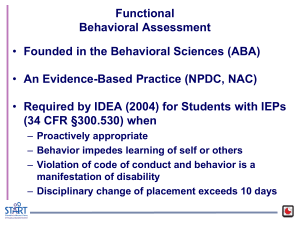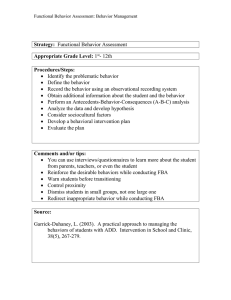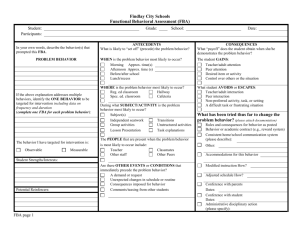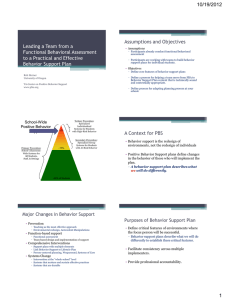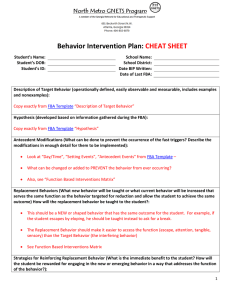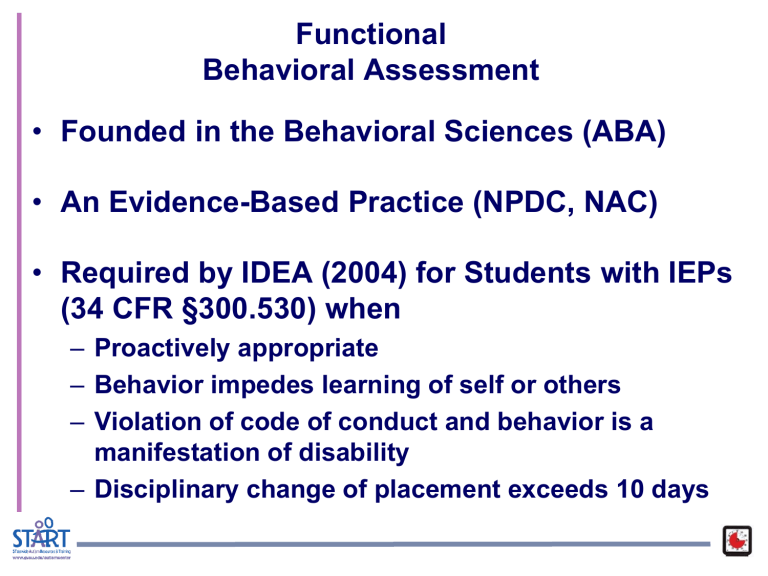
Functional Behavioral Assessment • Founded in the Behavioral Sciences (ABA) • An Evidence-Based Practice (NPDC, NAC) • Required by IDEA (2004) for Students with IEPs (34 CFR §300.530) when – Proactively appropriate – Behavior impedes learning of self or others – Violation of code of conduct and behavior is a manifestation of disability – Disciplinary change of placement exceeds 10 days A FBA is an Evaluation • Must follow the same regulations as other evaluations (§§300.301 – 300.305) • Written Parental Consent – (§300.300) • Procedural Safeguards (§300.504) • Prior Written Notice (§300.503) • Time lines – (R 340.1721b) • Is subject to an IEE per parent request Functional Behavioral Assessment INTENSIVE (A) Meeting Mechanics COMPREHENSIVE FBA (B) Functional Behavioral Analysis: --Hypothesis Testing --Changing Individual Variables --Variable Limited Environments TARGETED PRACTICAL FBA Meeting Mechanics Using Function to Develop Interventions UNIVERSAL Think in ABC / FBA to solve immediate problems Universal Supports w/ Fidelity Meeting Mechanics: Frontloading Practical vs. Comprehensive FBA Practical FBA Comprehensive FBA Practical FBA Utilized by School Staff Conducted by individuals trained in behavioral science (e.g. FBA school Comprehensive psych, behavior specialists) For students with mild to moderate target behaviors Used for students with moderate to severe target behaviors Behaviors occur in few environments Behaviors occur in a variety of settings Behaviors are not dangerous Behaviors are dangerous or intensive Does not include Functional Behavioral Analysis May include Functional Behavioral Analysis Goals of FBA 1. Establish a baseline of operationally defined target behavior(s) 2. Identify Antecedent Variables that predict the occurrence and nonoccurrence of target behavior(s) 3. Identify variables that maintain target behavior(s) (Consequence Variables) 4. Identify Potential Function(s) 5. Develop a Hypothesis (summary statement) BEHAVIOR PLAN FBA Timeline 1st week – Planning Meeting • Assign roles and responsibilities • Develop an assessment plan calendar • Review file including behavior incident reports, any available data or logs, and previous evaluations. • Determine data to be collected and design a data collection system • Begin FBA Interviews and Surveys • Begin Data Collection 2nd & 3rd weeks 4th week – Review Meeting • Continue Data Collection • Conduct Additional Interviews or Surveys, if needed • Conduct direct observations by all FBA team members in multiple environments. • Review, summarize & analyze data • Generate summary statements / hypotheses including antecedent and maintaining variables and possible functions of behavior. • Design PBIS plan including antecedent, teaching and responding strategies and interventions FBA using DASH • Describe Behavior – Prioritize – Operational Definition – Baseline Data • Ask Others – INDIRECT METHOD— Interviews / Surveys • See the Behavior – DIRECT METHOD– Observation – Scatterplot / ABC • Hypothesis MiBLSi, 2013 Data Collection / FBA Tools Purpose of Forms / TOOLS: GATHER & Organize Data / information Prompt to cover all basis DASH STEPS • Describe Behavior – Prioritize – Operational Definition – Baseline Data • Ask Others – INDIRECT METHOD— Interviews / Surveys • See the Behavior – DIRECT METHOD– Observation – Scatterplot / ABC • Hypothesis MiBLSi, 2013 PRIORITIZE Is it REALLY a Problem? Is it worth spending time / resources to address? In Comparison to Peers –Frequency? –Duration? –Intensity? Prioritizing Behaviors for Students with ASD Does the behavior interfere with opportunities in integrated environments? Does the behavior interfere with: Engagement? Independence? Socialization / Communication? Does the behavior interfere with progress toward IEP GOALS (impedes learning)? Operational Definition Observable Measurable 2 People Agree Baseline Data—The What and Why • What ABOUT the behavior, makes it a problem? – Frequency (count or interval recording) – Duration (amount of time) – Intensity (likert scale) DASH STEPS • Describe Behavior – Prioritize – Operational Definition – Baseline Data • Ask Others – INDIRECT METHOD— Interviews / Surveys • See the Behavior – DIRECT METHOD– Observation – Scatterplot / ABC • Hypothesis MiBLSi, 2013 FBA Indirect Assessment Tools • QABF: Questions About Behavioral Function • FACTS: Functional Assessment Checklist for Teachers and Staff • FAST: Functional Analysis / Assessment Screening Tool • MAS: Motivation Assessment Scale • ATS Functional Interview DASH STEPS • Describe Behavior – Prioritize – Operational Definition – Baseline Data • Ask Others – INDIRECT METHOD— Interviews / Surveys • See the Behavior – DIRECT METHOD– Observation – Scatterplot / ABC • Hypothesis MiBLSi, 2013 Logistics of DIRECT Data Collection • Where (locations) will you collect data? • When (times) will you collect it? • Who will collect it? • For how long will we collect it before we summarize it and develop / complete a PBIS plan? Getting Information About Variables Scatterplot: Potential Variables / Function? Student: Jason TARGET BEHAVIOR: When asked to work will refuse to begin to work and repeat concerns about ability to do work correctly. Observer: Stichter Dates: 4-25-99 – 5-5-00 DATES Time Activity M T W T F M T W T F 8:00 – 8:30 Opening X O O O O X O O O O 8:30 – 9:15 Language arts X 9:15 – 10:00 P.E. O O O O O O O O O O 10:00 – 10:15 Snack O O O O O O O O O O 10:15-10:40 Clean-up / Free Time O X O O O X O O X X 10:40-11:20 Math X O O O O X O O O O 11:20-12:00 Music X O O X O X 12:00-12:30 Lunch O O O O O O O O O O 12:30-1:15 Independent seatwork/reading group X X X 1:15-1:45 Life Skills X O O O O X O O O O 1:45-2:15 Science / Social Studies X O X X 2:15-2:45 Prepare for home and bus X O O O O X O O O O O Behavior did not occur X Behavior occurred / X X O O X O X X O O X O O O X X X O X X X X X O X O Did not observe ABC Data Collection Antecedent Behavior Consequence What happens What happens What happens BEFORE DURING AFTER When Ø / Where Ø / With Whom Ø / Under What Conditions Ø Cues to Function The ABC Paradigm ANTECEDENT BEHAVIOR CONSEQUENCE BEFORE DURING AFTER Understanding BEHAVIOR using the ABC Paradigm REINFORCEMENT PUNISHMENT CONDITIONS BEFORE Antecedent Behavior Consequence No Big Stick or Sr Requires you to WAIT for behavior Types of Sr and Punishment Reinforcement Positive = Give Negative = Remove POSITIVE Sr NEGATIVE Sr (ESCAPE) Punishment POSITIVE Punishment NEGATIVE Punishment Functional Behavioral Assessment: What are the VARIABLES Associated with the Behavior? Foundation for a PBIS Plan CONDITIONS BEFORE Antecedent • • • • • • Behavior Where (locations) / Where Ø When (time) / When Ø Who (peers / adults) / Ø Demands / Expectations Environmental Arrangement Instruction / Curriculum • • • • • • Consequence Structured vs. Unstructured Level of Support Daily Schedule / Transitions Adult Attitudes Sensory (ex. Noise Level; Lights) OTHERS? Addressing Student Problem Behavior-Part II; Conducting a Functional Behavioral Assessment (1998); Center for Effective Collaboration and Practice Functional Behavioral Assessment: What are the VARIABLES Associated with the Behavior? Foundation for a PBIS Plan CONDITIONS AFTER Antecedent • • • • • Behavior Consequence PATTERNS of Conditions AFTER Conditions that MAINTAIN behavior Positive Reinforcement Negative Reinforcement CUES to Function Addressing Student Problem Behavior-Part II; Conducting a Functional Behavioral Assessment (1998); Center for Effective Collaboration and Practice Functions of Behavior GET Something (Positive Reinforcement) AVOID Something (Negative Reinforcement) INTERNAL EXTERNAL INTERNAL EXTERNAL Relaxation Self-Stimulation Justice/Fairness Sensory Input Enjoyment Attention Choice Objects/$ Praise Preferred Activities Failure Embarrassment Boredom Anxiety Task Sensory Input Peers/Teacher Homework Chores Adapted in part from Addressing Student Problem Behavior—Part III: Creating Positive Behavioral Intervention Plans and Supports (Center for Effective Collaboration and Practice, 2000) Determining Function Ask: If non-contingent access / avoidance, will the behavior stop? Avoid Assumptions / Attributions • • • • • • • • • • • • • Manipulative Defiant / Non-compliant Stubborn Lazy Argumentative Has Sensory Issues Disrespectful Attention-Getting Own Worst Enemy Not Motivated Uncooperative Selfish “He can do it if he WANTS to” Fundamental Attribution Error You See You Assume More Likely Disorganization Doesn’t ask for help Wanders Laziness Non-compliance Lack of motivation Lack of understanding Theory of mind deficit Filling down time Resistance to change Engages in repetitive activities Perfectionism Stubbornness Non-compliance OCD Keep world predictable Reduce anxiety Follow expectations Literal interpretation Constant repetitive questions Attempt to annoy Sarcastic Not understanding Needs verification Example ABC Chart: Potential Variables / Function? Antecedent Lang Arts Science Spec. Ed. Math When asked to work on independent work. Behavior Jason sits & initially does nothing, and then begins to verbal perseverate over why it won’t be right. Consequence Teacher comes over and talks/reasons with him and he gets started doing his work. Class working on independent assignments, teacher busy with a peer. Jason mumbles “I can’t do this, it’s all wrong.” Teacher sees him not working, tells him to begin, and stands next to him telling him it’s not wrong up until he begins. (<5 mins.) When given multiple worksheets Jason sits quietly at desk looking around the room and eventually begins to verbally perseverate over his ability to do the work correctly. Begins work shortly after the teacher sits at table with him. When given independent work, teacher immediately goes to Jason for support / assistance. Jason immediately gets to work on his math assignment. Teacher monitors the class and periodically (every 8-10 minutes) checks on Jason to see if he needs help. DASH STEPS • Describe Behavior – Prioritize – Operational Definition – Baseline Data • Ask Others – INDIRECT METHOD— Interviews / Surveys • See the Behavior – DIRECT METHOD– Observation – Scatterplot / ABC • Hypothesis MiBLSi, 2013 Hypothesis / Summary Statement Antecedent Behavior Consequence Under these conditions, The student does this, In order to get / avoid what Observable / Measurable (VERBS) FUNCTIONS When Ø / Where Ø / With Whom Ø / Under What Conditions Ø Example Summary of Variables Data Analysis / Hypothesis Statement Antecedent Under these CONDITIONS Behavior Student does WHAT Consequence And then THIS HAPPENS: (FUNCTION—Get / Avoid) --When asked to work on independent work or when given multiple worksheets --and adult support is irregular or not provided --sits & does nothing --or begins to verbally perseverate over why it won’t be right --Adult support is provided --Anxiety is reduced FBA & BIP Development Summary Statement ANTECEDENT BEHAVIOR CONSEQUENCE BEFORE DURING AFTER Foundation for PBIS Plan PREVENT TEACH challenging behavior from occurring in the first place…. new skills RESPOND in ways that: Reinforce new behaviors Do not reinforce challenging behavior; Prevent further escalation

